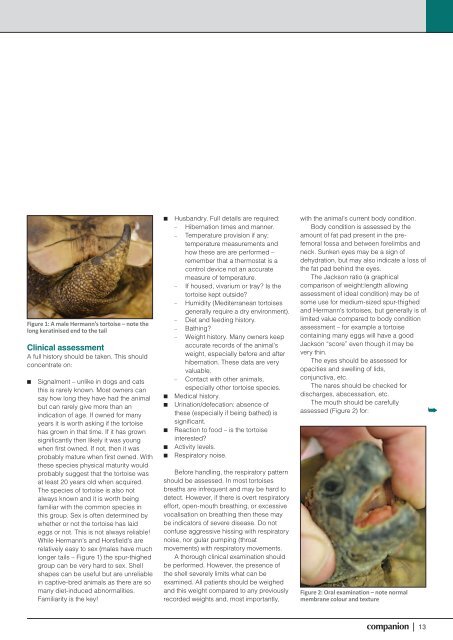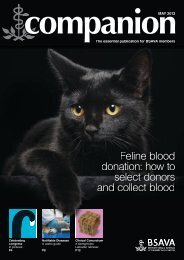the anorexic tortoise - BSAVA
the anorexic tortoise - BSAVA
the anorexic tortoise - BSAVA
You also want an ePaper? Increase the reach of your titles
YUMPU automatically turns print PDFs into web optimized ePapers that Google loves.
Figure 1: A male Hermann’s <strong>tortoise</strong> – note <strong>the</strong><br />
long keratinised end to <strong>the</strong> tail<br />
Clinical assessment<br />
A full history should be taken. This should<br />
concentrate on:<br />
■■ Signalment – unlike in dogs and cats<br />
this is rarely known. Most owners can<br />
say how long <strong>the</strong>y have had <strong>the</strong> animal<br />
but can rarely give more than an<br />
indication of age. If owned for many<br />
years it is worth asking if <strong>the</strong> <strong>tortoise</strong><br />
has grown in that time. If it has grown<br />
significantly <strong>the</strong>n likely it was young<br />
when first owned. If not, <strong>the</strong>n it was<br />
probably mature when first owned. With<br />
<strong>the</strong>se species physical maturity would<br />
probably suggest that <strong>the</strong> <strong>tortoise</strong> was<br />
at least 20 years old when acquired.<br />
The species of <strong>tortoise</strong> is also not<br />
always known and it is worth being<br />
familiar with <strong>the</strong> common species in<br />
this group. Sex is often determined by<br />
whe<strong>the</strong>r or not <strong>the</strong> <strong>tortoise</strong> has laid<br />
eggs or not. This is not always reliable!<br />
While Hermann’s and Horsfield’s are<br />
relatively easy to sex (males have much<br />
longer tails – Figure 1) <strong>the</strong> spur-thighed<br />
group can be very hard to sex. Shell<br />
shapes can be useful but are unreliable<br />
in captive-bred animals as <strong>the</strong>re are so<br />
many diet-induced abnormalities.<br />
Familiarity is <strong>the</strong> key!<br />
■■ Husbandry. Full details are required:<br />
– ■ Hibernation times and manner.<br />
– ■ Temperature provision if any;<br />
temperature measurements and<br />
how <strong>the</strong>se are are performed –<br />
remember that a <strong>the</strong>rmostat is a<br />
control device not an accurate<br />
measure of temperature.<br />
– ■ If housed, vivarium or tray? Is <strong>the</strong><br />
<strong>tortoise</strong> kept outside?<br />
– ■ Humidity (Mediterranean <strong>tortoise</strong>s<br />
generally require a dry environment).<br />
– ■ Diet and feeding history.<br />
– ■ Bathing?<br />
– ■ Weight history. Many owners keep<br />
accurate records of <strong>the</strong> animal’s<br />
weight, especially before and after<br />
hibernation. These data are very<br />
valuable.<br />
– ■ Contact with o<strong>the</strong>r animals,<br />
especially o<strong>the</strong>r <strong>tortoise</strong> species.<br />
■■ Medical history.<br />
■■ Urination/defecation: absence of<br />
<strong>the</strong>se (especially if being ba<strong>the</strong>d) is<br />
significant.<br />
■■ Reaction to food – is <strong>the</strong> <strong>tortoise</strong><br />
interested?<br />
■■ Activity levels.<br />
■■ Respiratory noise.<br />
Before handling, <strong>the</strong> respiratory pattern<br />
should be assessed. In most <strong>tortoise</strong>s<br />
breaths are infrequent and may be hard to<br />
detect. However, if <strong>the</strong>re is overt respiratory<br />
effort, open-mouth breathing, or excessive<br />
vocalisation on breathing <strong>the</strong>n <strong>the</strong>se may<br />
be indicators of severe disease. Do not<br />
confuse aggressive hissing with respiratory<br />
noise, nor gular pumping (throat<br />
movements) with respiratory movements.<br />
A thorough clinical examination should<br />
be performed. However, <strong>the</strong> presence of<br />
<strong>the</strong> shell severely limits what can be<br />
examined. All patients should be weighed<br />
and this weight compared to any previously<br />
recorded weights and, most importantly,<br />
with <strong>the</strong> animal’s current body condition.<br />
Body condition is assessed by <strong>the</strong><br />
amount of fat pad present in <strong>the</strong> prefemoral<br />
fossa and between forelimbs and<br />
neck. Sunken eyes may be a sign of<br />
dehydration, but may also indicate a loss of<br />
<strong>the</strong> fat pad behind <strong>the</strong> eyes.<br />
The Jackson ratio (a graphical<br />
comparison of weight:length allowing<br />
assessment of ideal condition) may be of<br />
some use for medium-sized spur-thighed<br />
and Hermann’s <strong>tortoise</strong>s, but generally is of<br />
limited value compared to body condition<br />
assessment – for example a <strong>tortoise</strong><br />
containing many eggs will have a good<br />
Jackson “score” even though it may be<br />
very thin.<br />
The eyes should be assessed for<br />
opacities and swelling of lids,<br />
conjunctiva, etc.<br />
The nares should be checked for<br />
discharges, abscessation, etc.<br />
The mouth should be carefully<br />
assessed (Figure 2) for:<br />
Figure 2: Oral examination – note normal<br />
membrane colour and texture<br />
companion | 13



